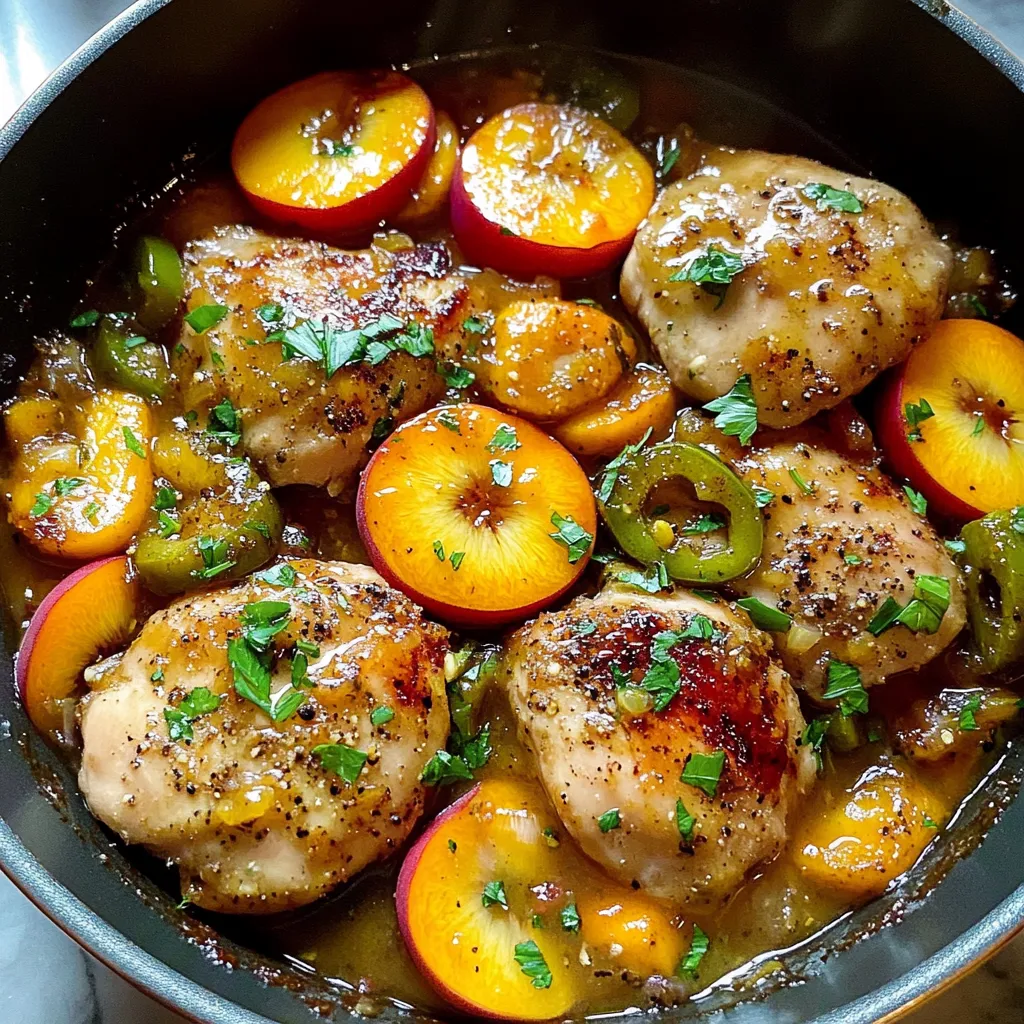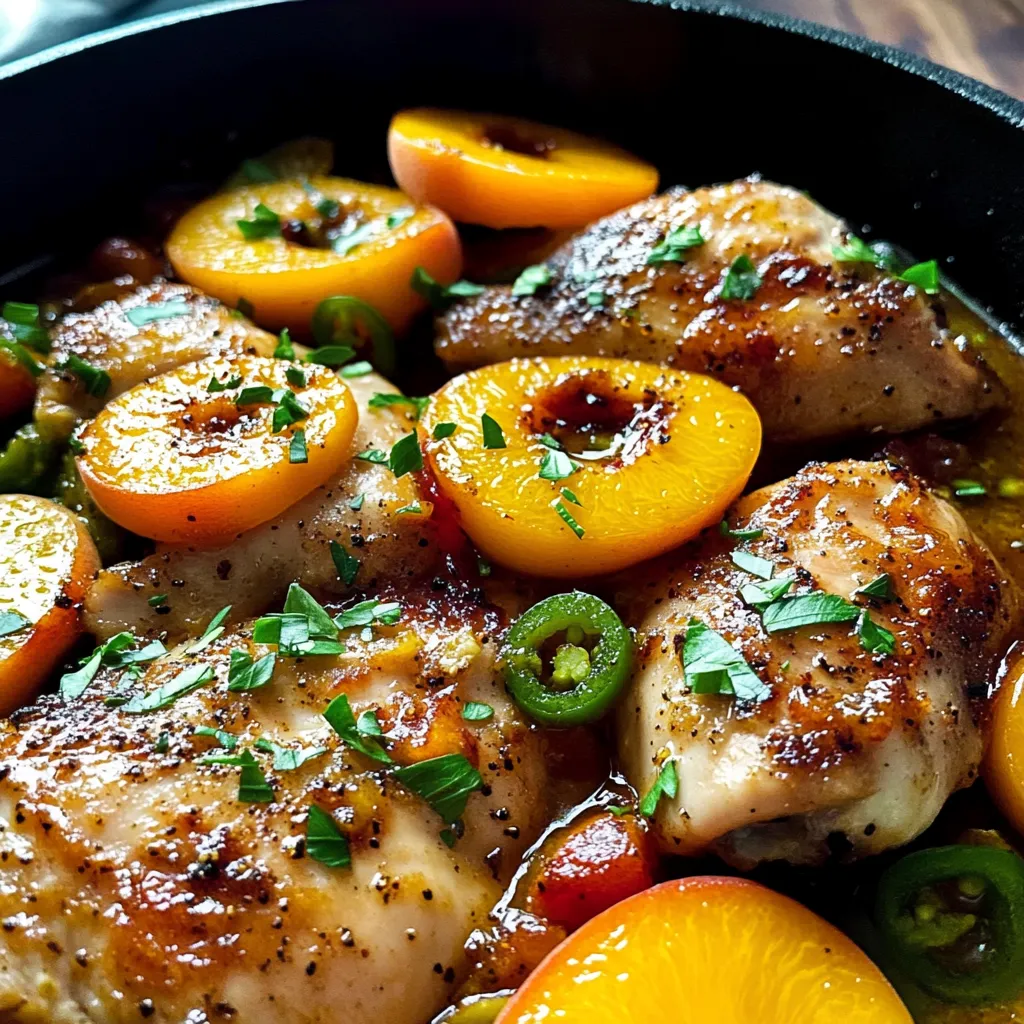 Pin it
Pin it
This sweet and spicy chicken dish brings together the perfect balance of juicy peaches and fiery jalapeños in a sauce that transforms ordinary chicken thighs into something absolutely restaurant-worthy. The natural sweetness from fresh peaches and peach preserves mellows the heat from the jalapeños, while Worcestershire sauce and Dijon mustard add layers of complexity that make every bite interesting. Unlike complicated chicken recipes that require hours of prep, this skillet meal delivers incredible flavor in just 40 minutes using simple techniques that anyone can master.
I stumbled upon this flavor combination during peach season when I had jalapeños left over from another recipe and decided to experiment. The first time I made it, my family devoured every piece and immediately asked when I'd be making it again. Now it's become our go-to summer dinner when we want something that feels special but doesn't require a lot of fuss.
Essential Ingredients and Selection Tips
- Boneless chicken thighs: Look for pieces that are roughly the same thickness for even cooking; thighs stay more tender than breasts and have better flavor
- Fresh peaches: Choose fruit that gives slightly to gentle pressure but isn't mushy; the skin should be fragrant and free from dark spots or bruises
- Fresh jalapeños: Select peppers that are firm and bright green without soft spots; smaller peppers tend to be hotter than larger ones
- Peach preserves: Choose high-quality preserves with visible fruit pieces; apricot preserves work as an excellent substitute if peach isn't available
- Worcestershire sauce: This complex condiment adds umami depth that elevates the entire dish; don't skip it as there's no good substitute
- Dijon mustard: The tangy sharpness cuts through the sweetness and adds beautiful color; yellow mustard won't provide the same sophisticated flavor
- Red pepper flakes: Use within a year of purchase for maximum heat and flavor; older spices lose their potency significantly
The key to this dish is balancing the sweet and spicy elements so neither overpowers the other. Fresh ingredients make all the difference in achieving that perfect harmony of flavors.
Detailed Step-by-Step Instructions
- Step 1: Prepare the fruits and vegetables:
- Wash the peaches thoroughly and slice them into thin wedges about ¼-inch thick, leaving the skin on for better texture and color. Remove the stem from the jalapeños and slice them into thin rounds - keep the seeds if you want more heat, or remove them for a milder flavor. Place both the peach slices and jalapeño rounds in a medium bowl and set aside while you prepare the sauce mixture.
- Step 2: Create the sauce mixture:
- In the same bowl with the peaches and jalapeños, add the peach preserves, Worcestershire sauce, Dijon mustard, red pepper flakes, dried minced onion, and dried minced garlic. Stir everything together until well combined, making sure the preserves are evenly distributed and the spices are incorporated throughout. The mixture should look glossy and coat the fruit pieces nicely.
- Step 3: Prepare the chicken:
- Pat the chicken thighs completely dry with paper towels - this is crucial for getting a good sear and preventing splattering. Season both sides generously with salt and freshly ground black pepper, pressing the seasonings into the meat slightly to help them adhere during cooking.
- Step 4: Heat the skillet properly:
- Place a large, heavy-bottomed skillet or cast iron pan over medium-high heat and let it get hot for 2-3 minutes. You'll know it's ready when a drop of water sizzles and evaporates immediately. Add a thin layer of oil - just enough to coat the bottom of the pan.
- Step 5: Sear the first side:
- Carefully place the seasoned chicken thighs in the hot skillet, making sure not to overcrowd the pan. Let them cook undisturbed for exactly 5 minutes - resist the urge to move or peek at them, as this prevents proper browning. You should hear a steady sizzling sound throughout this time.
- Step 6: Flip and sear the second side:
- Using tongs, flip each piece of chicken to the other side and cook for another 5 minutes without moving them. The first side should be golden brown and release easily from the pan when properly seared. Continue cooking the second side until it's also beautifully browned.
- Step 7: Final cooking phase:
- Flip the chicken one more time and cook for an additional 4 minutes. At this point, the chicken should be nearly cooked through but will finish cooking with the sauce. Use a meat thermometer to check that the internal temperature is approaching 160°F.
- Step 8: Add the sauce and finish:
- Pour the peach and jalapeño mixture directly over the chicken in the skillet, making sure to scrape all the sauce from the bowl. The liquid will bubble vigorously at first - this is normal. Reduce the heat to medium and let everything simmer together for 3 minutes, allowing the sauce to thicken slightly and the flavors to meld.
- Step 9: Final mixing and glazing:
- Gently stir the chicken and sauce together for the final 2 minutes, spooning the sauce over the chicken pieces to create a beautiful glaze. The internal temperature of the chicken should reach 165°F, and the sauce should be thick enough to coat the chicken nicely.
 Pin it
Pin it
The most critical step is not moving the chicken during the initial searing phases. This creates that golden-brown crust that locks in juices and provides the perfect base for the sauce to adhere to.
Growing up, my grandmother always said that the best dishes come from unexpected combinations, and this recipe perfectly proves her point. The first time I served this to guests, they couldn't stop asking about the unique flavor combination - there's something magical about how the sweetness and heat play off each other while the chicken stays incredibly tender and juicy.
Understanding Chicken Thigh Cooking Techniques
Chicken thighs are more forgiving than breasts because their higher fat content prevents them from drying out easily, but proper technique still matters for optimal results. The key is achieving a good sear first, which creates a flavorful crust and helps seal in juices. Unlike chicken breasts, thighs can handle slightly higher heat and longer cooking times without becoming tough. The connective tissue in thighs actually breaks down during cooking, contributing to their incredibly tender texture. When checking for doneness, thighs should reach 165°F internal temperature, but they can safely go a few degrees higher without becoming dry, unlike more delicate breast meat.
Balancing Sweet and Spicy Flavor Profiles
The magic of this dish lies in the careful balance between sweet and spicy elements, creating complexity without overwhelming any single flavor. Peaches provide natural fruitiness and gentle sweetness, while the preserves add concentrated fruit flavor and help create the sauce base. Jalapeños contribute both heat and a bright, vegetal flavor that cuts through the richness. The Worcestershire sauce adds umami depth that bridges the sweet and spicy elements, while Dijon mustard provides acidity and sharpness that prevents the dish from becoming cloying. This balance is what makes the dish interesting rather than just sweet or just spicy.
Sauce Development and Glazing Techniques
The sauce in this recipe serves multiple purposes - it's both a cooking medium and a finishing glaze that creates beautiful presentation. As the sauce cooks with the chicken, the natural juices from the meat combine with the fruit preserves and seasonings, creating a complex flavor base. The sugars in the peaches and preserves caramelize slightly against the hot pan, adding depth and helping the sauce adhere to the chicken. The final stirring phase is crucial for coating each piece evenly and ensuring the sauce reaches the right consistency - thick enough to cling but not so thick that it becomes sticky or overly sweet.
Fresh Ingredient Selection and Seasonal Considerations
Using fresh peaches makes a significant difference in both flavor and texture compared to canned alternatives. Fresh peaches hold their shape better during cooking and provide natural sweetness without the syrupy quality of canned fruit. When peaches aren't in season, firm pears or fresh apricots make excellent substitutions that maintain the recipe's integrity. Fresh jalapeños are essential for proper heat balance and bright flavor - dried or pickled jalapeños would change the entire character of the dish. The ripeness of your peaches affects the final flavor balance, so taste and adjust the preserves accordingly if your fruit is particularly sweet or tart.
One-Pan Cooking Methods and Heat Management
This recipe showcases the efficiency of one-pan cooking while building complex flavors through proper heat management. Starting with high heat for searing creates the foundational flavors, while reducing heat for the sauce phase prevents burning and allows for proper melding of ingredients. The residual heat from the pan continues cooking the chicken gently while the sauce reduces, creating that perfect glossy finish. Understanding when to adjust heat levels is crucial - too high during the sauce phase can cause the sugars to burn, while too low won't provide enough evaporation to concentrate flavors properly.
This jalapeño peach chicken has taught me that some of the most memorable dishes come from combining ingredients that seem like they shouldn't work together but somehow create perfect harmony. Every time I make it, I'm reminded that cooking is really about balancing flavors and textures in ways that surprise and delight, proving that simple techniques with quality ingredients can create something truly special.
Frequently Asked Questions
- → Can I use chicken breasts instead of thighs?
- Yes, but cook for less time since breasts cook faster and can dry out. Check that internal temperature reaches 165°F.
- → What if I can't find peach preserves?
- Apricot preserves work great as a substitute. You can also use orange marmalade or even honey for sweetness.
- → How spicy is this dish?
- It's mildly spicy. Remove jalapeño seeds for less heat, or add more jalapeños if you like it hotter.
- → Can I make this ahead of time?
- This tastes best fresh, but you can prep the sauce mixture earlier in the day and store it in the fridge.
- → What sides go well with this chicken?
- Rice, mashed potatoes, or roasted vegetables work perfectly. The sauce is great over anything that can soak it up.
- → Do I need to peel the peaches?
- No need to peel them. The skin adds nice texture and color to the dish, plus it saves time.
